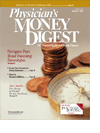Publication
Article
Physician's Money Digest
Where Should You Invest as Rates Rise?
Author(s):
There has been a great deal ofmumblings on the rising rates ofinflation, and, consequently, federalinterest. In June, the Federal Reserveraised the interest rate 0.25%, and AlanGreenspan hinted at further increases tocome. The policy shift has implicationsfor savings and investments that physician-investors should be aware of. In particular,intermediate and long-term bondfunds are currently a great risk to portfolios.These bonds will lose value asinterest rates continue to rise over thenext several years.
Following are two strategies for investingyour money during this environmentof rising interest rates.
Laddered Bonds
Example:
This is a simple approach that allowsyour money to move with changing interestrates. Divide your money into 5 to 10equal portions and then buy bonds or CDswith maturities of 1, 5, or 10 years. Say you have $100,000 thatyou're taking from a bond mutual fundto invest in your laddered bond strategy.Dividing your money into 10 equal portions,you buy your first $10,000 bondwith a maturity of 1 year. Your secondbond should mature in 2 years, your thirdbond in 3 years, and so on, until you haveinvested in 10 bonds. As interest ratesrise, within 12 months, your first bondwill mature and you will use the proceedsto buy a new bond that matures in 10years at the new higher interest rate.
This strategy allows your portfolio tomove with changing interest rates, nomatter how far up they eventually rise orfall. For competitive rates on CDs, visitmy company's Web site (www.welchgroup.com). At the bottom of the homepage, click on "Cool Links," and then"Best CD Rates." For helpful informationon bonds, go to the bond section atYahoo! Finance on the Internet.
Dividend-Paying Stocks
Dividends paid by corporations nowreceive favorable tax treatment, makingthem a favorite choice for investors willingto take on a bit more risk thanbonds. In the past, corporate dividendswere taxed as ordinary income. In 2003,Congress passed legislation that reducedfederal taxes on corporate dividends to amaximum of 15%.
When searching for these stocks,make sure you look for companies withstrong balance sheets, solid cash flows,and long histories of paying dividendswithout interruption. You will want toown a minimum of 20 different stocks inat least six different industries to helpdiversify your risks. You should be able toput together a basket of high-qualitydividend stocks yielding in excess of 3%.
Considering that the dividends receivefavorable tax treatment and you havegood long-term opportunity for growth,this may be an excellent strategy shouldinflation begin to heat up. An inexpensiveway to implement this strategy is toinvest in an exchange-traded fund (ETF)that focuses on dividend stocks. For moreinformation on ETFs, visit www.welchgroup.com. At the bottom of the homepage, click on "Cool Links," and then"Exchange Traded Funds."
Stewart H. Welch III, CFP®, AEP,founder of The Welch Group,has been rated one of the nation'stop financial advisors by Moneyand Worth. He welcomes questionsor comments from readersat 800-709-7100 or www.welchgroup.com. Reprintedwith permission from the Birmingham Post Herald.
